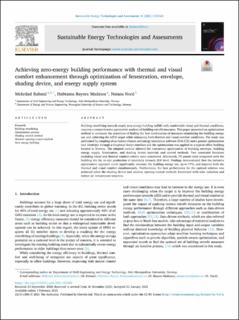| dc.contributor.author | Rabani, Mehrdad | |
| dc.contributor.author | Madessa, Habtamu Bayera | |
| dc.contributor.author | Nord, Natasa | |
| dc.date.accessioned | 2021-02-22T12:04:28Z | |
| dc.date.available | 2021-02-22T12:04:28Z | |
| dc.date.created | 2021-01-28T10:16:18Z | |
| dc.date.issued | 2021 | |
| dc.identifier.issn | 2213-1388 | |
| dc.identifier.uri | https://hdl.handle.net/11250/2729496 | |
| dc.description.abstract | Building retrofitting towards nearly zero energy building (nZEB) with comfortable visual and thermal conditions, requires a comprehensive parametric analysis of building retrofit measures. This paper presented an optimization method to automate the procedure of finding the best combination of measures minimizing the building energy use and achieving the nZEB target while enhancing both thermal and visual comfort conditions. The study was performed by coupling of an Indoor climate and energy simulation software (IDA-ICE) and a generic optimization tool (GenOpt) through a Graphical Script interface and the optimization was applied to a typical office building located in Norway. The adopted method allowed the concurrent optimization of building envelope, building energy supply, fenestration, and shading device material, and control methods. Two constraint functions including visual and thermal comfort criteria were considered. Afterwards, PV panels were integrated with the building site for on-site production of electricity towards ZEB level. Findings demonstrated that the inclusive optimization approach could significantly decrease the building energy use, up to 77%, and improve both the thermal and visual comfort simultaneously. Furthermore, the best performance for the optimal solution was achieved when the shading device and window opening control methods functioned with solar radiation and indoor air temperature setpoints. | en_US |
| dc.language.iso | eng | en_US |
| dc.publisher | Elsevier | en_US |
| dc.rights | Navngivelse 4.0 Internasjonal | * |
| dc.rights.uri | http://creativecommons.org/licenses/by/4.0/deed.no | * |
| dc.title | Achieving zero-energy building performance with thermal and visual comfort enhancement through optimization of fenestration, envelope, shading device, and energy supply system | en_US |
| dc.type | Peer reviewed | en_US |
| dc.type | Journal article | en_US |
| dc.description.version | publishedVersion | en_US |
| dc.source.journal | Sustainable Energy Technologies and Assessments | en_US |
| dc.identifier.doi | 10.1016/j.seta.2021.101020 | |
| dc.identifier.cristin | 1880994 | |
| dc.description.localcode | 2021 The Author(s). Published by Elsevier Ltd. This is an open access article under the CC BY license (http://creativecommons.org/licenses/by/4.0/). | en_US |
| cristin.ispublished | true | |
| cristin.fulltext | postprint | |
| cristin.qualitycode | 1 | |

